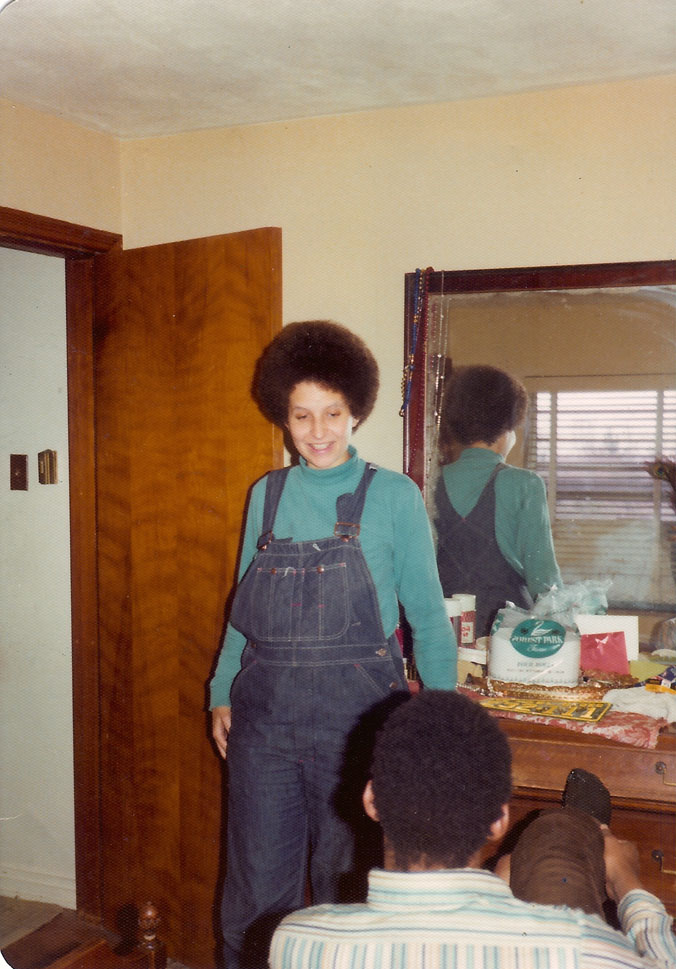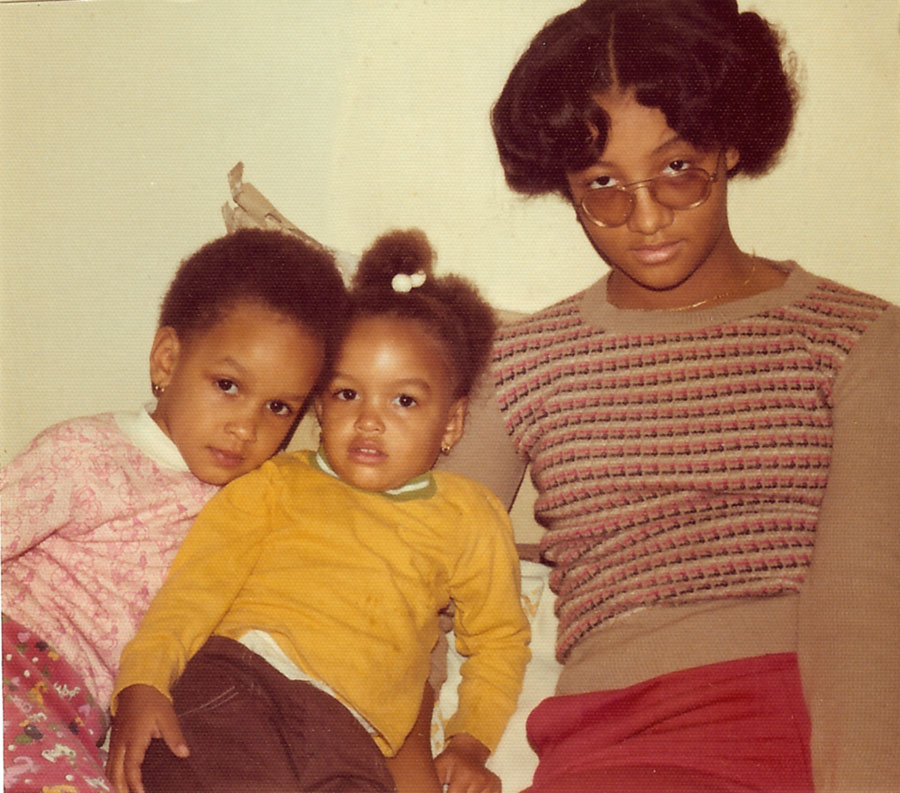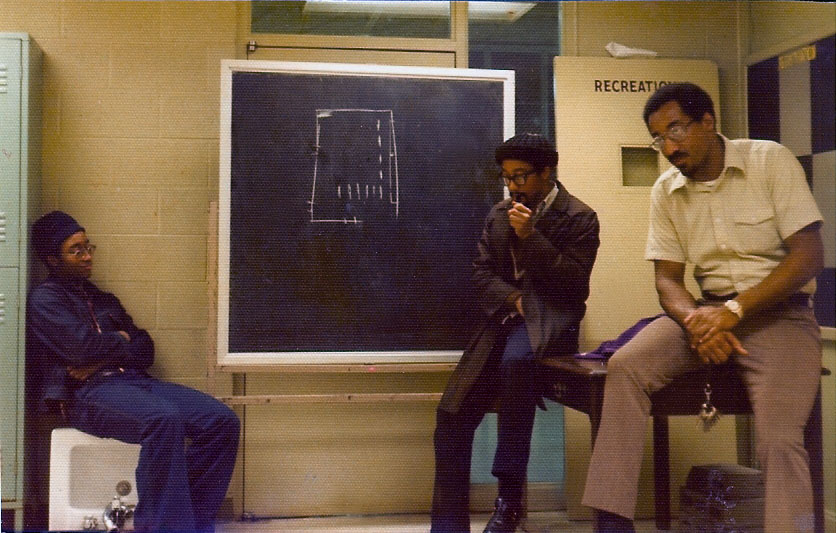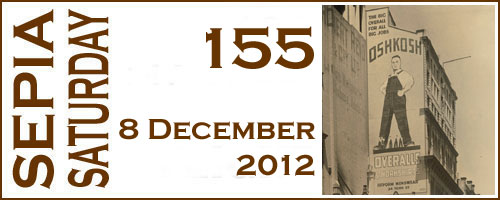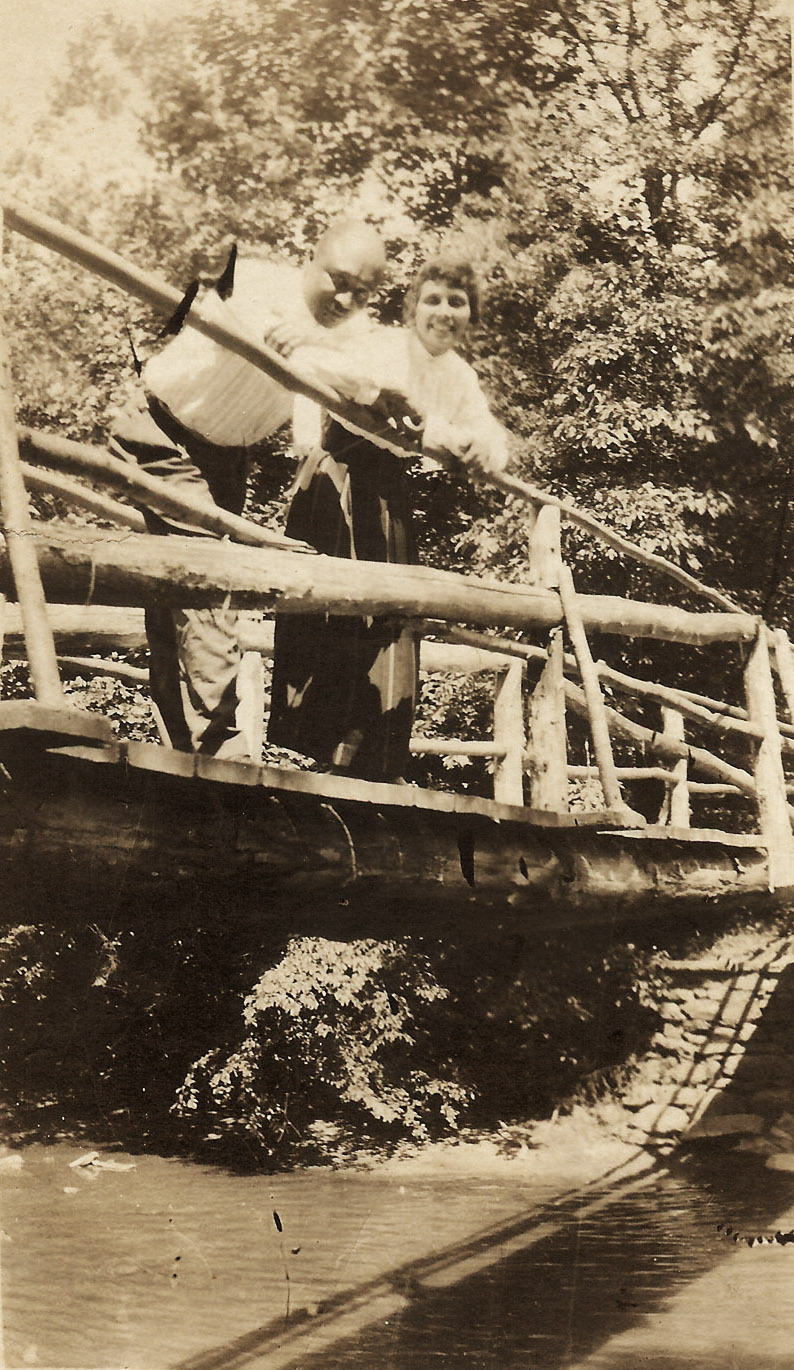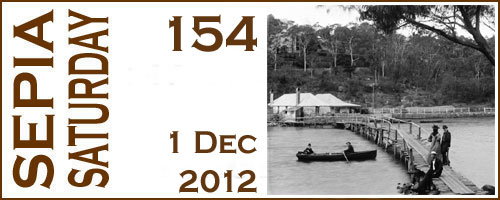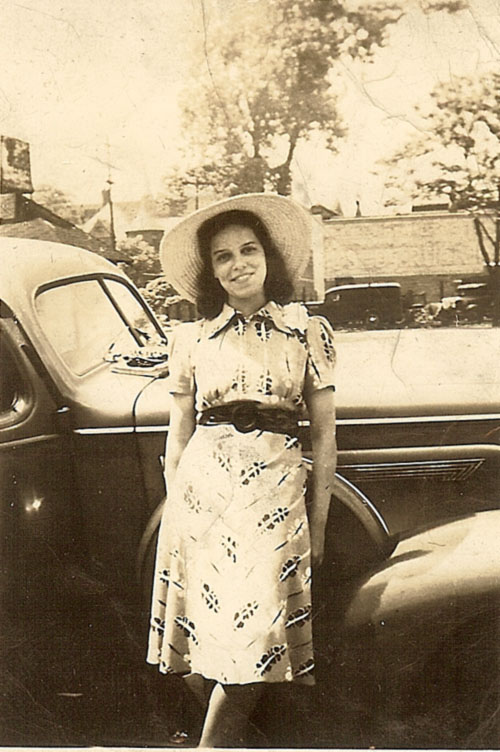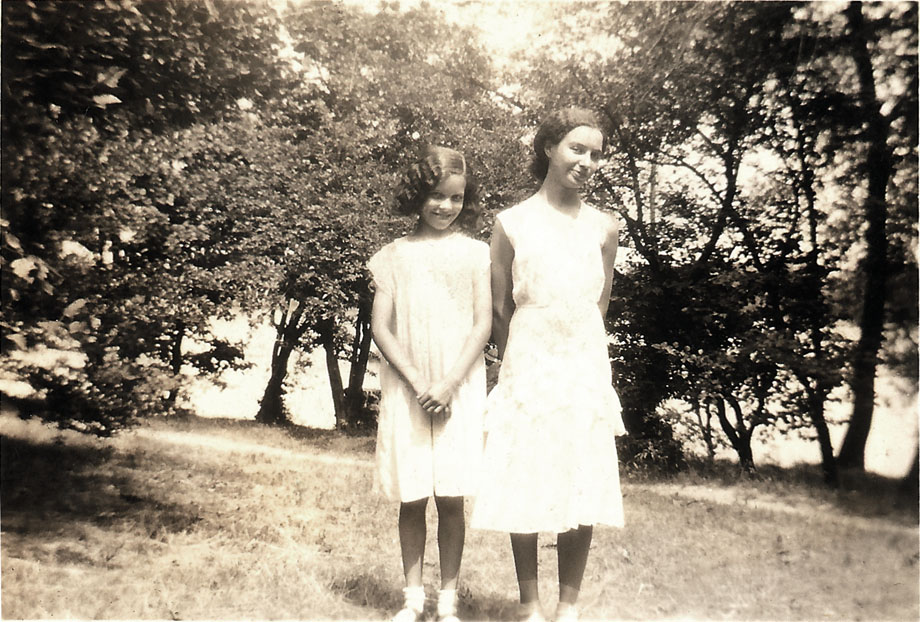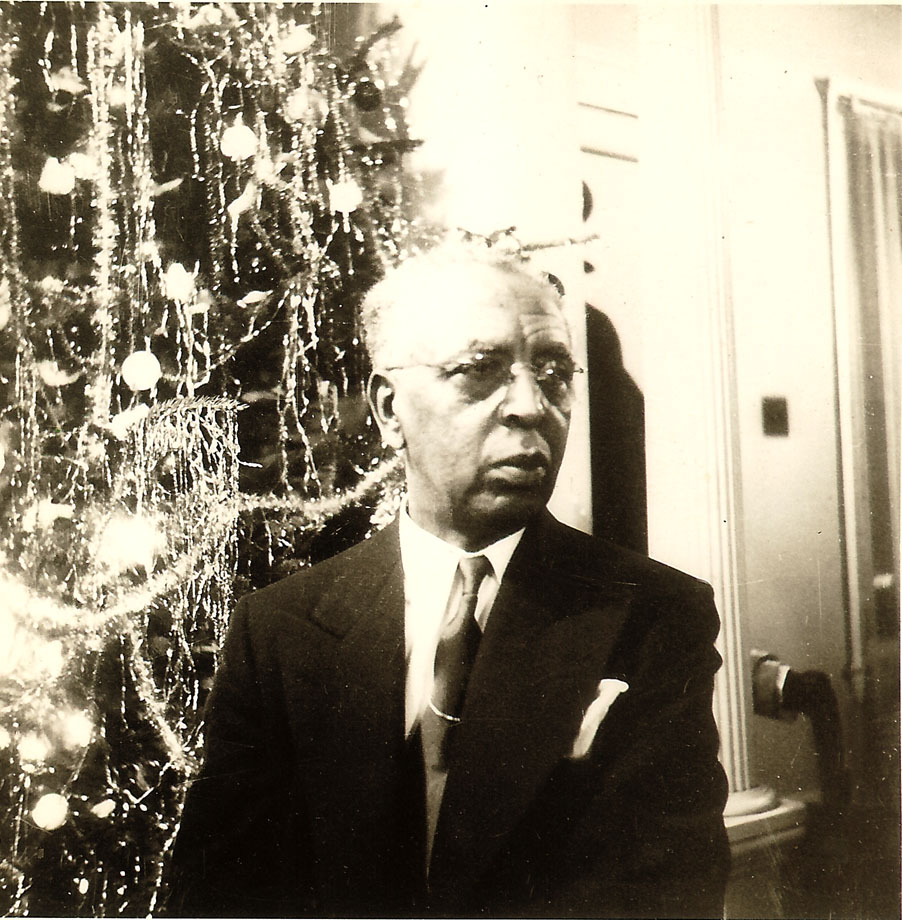

THE 2012 CHRISTMAS GENEAMEME
 This post is in response to the Deck the Halls Geneameme over at the Family History Across the Sea Blog. To participate or find links to more blogs doing the meme, click on the candles to the left. Thanks to Pauleen for putting this together.
This post is in response to the Deck the Halls Geneameme over at the Family History Across the Sea Blog. To participate or find links to more blogs doing the meme, click on the candles to the left. Thanks to Pauleen for putting this together.

- Do you have any special Xmas traditions in your family? In addition to having a Christmas tree we also set up a manger. When the children were home or my granddaughter is here we set it up at the beginning of Advent and move Mary and Joseph along day by to to arrive at the stable on Christmas Eve. Jesus appears at midnight and the three wise men start their journey, arriving on Epiphany.
- Is church attendance an important part of your Christmas celebrations and do you go the evening before or on Xmas Day? Some of us attend Church services and some don’t. Those who do go to the night service on Christmas Eve.
- Did/do you or your children/grandchildren believe in Santa? None of us believe in Santa.
- Do you go carolling in your neighbourhood? There have been times when we caroled but not recently. Click on the link to read about my youngest son’s caroling experience.
- What’s your favourite Christmas music? Click on the link to hear my favorite Christmas song which is Christmas in the Trenches.
- What’s your favourite Christmas carol? My favorite Christmas carol is We Three Kings and you can click on the link to hear it played on hang drums.
- Do you have a special Xmas movie/book you like to watch/read? In the past I used to watch It’s a Wonderful Life and A Christmas Carol on television but since I no longer have a television, I listen to Dylan Thomas’ A Child’s Christmas in Wales, which you can hear by clicking on the link.
- Does your family do individual gifts, gifts for littlies only, Secret Santa (aka Kris Kringle)? I have 5 children and 6 grandchildren who live in the same city my husband and I do, Atlanta, GA. On Christmas evening they all come over to my house. After we eat dinner, we open all the gifts. At this time my children, grandchildren and we the parents give gifts to everyone of us. They aren’t expensive gifts but there are a lot of them. You can see some of us just before opening our gifts on Christmas day in 2011 above.
- Is your main Christmas meal indoors or outdoors, at home or away? Christmas dinner is indoors at our house.
- What do you eat as your main course for the Christmas meal? You can read a description of our usual Christmas dinner, with a photo by clicking the link above. It is the same dinner my grandparents and my mother cooked, with a few changes – turkey with cornbread stuffing, greens, rice, green salad, rolls (my grandmother had biscuits), cranberry jelly (my grandmother’s came from a can, we make ours with fresh cranberries), candied sweet potatoes, macaroni and cheese. We also have brisket and various desserts – sweet potato and mince meat pie, or cheesecake, pound cake, fruitcake.
- Do you have a special recipe you use for Xmas? I make my own fruitcake from a combination of various recipes and changes I make. Click on the link to see me mixing it up. I have a bowl of mixed dried fruit and I need to go on and finish the cakes! I am so late.
- Does Christmas pudding feature on the Xmas menu? Is it your recipe or one you inherited? We had no Christmas pudding on the table.
- Do you have any other special Christmas foods? What are they? Not that I can think of.
- Do you give home-made food/craft for gifts at Christmas? Sometimes I give fruitcake and sometimes various children or adults make cookies to give. Click the link to see some of the gift cookies.
- Do you return to your family for Xmas or vice versa? Our family is mostly in Atlanta. One son and granddaughter live in other cities. This will be the first Christmas she hasn’t spent with us in 5 years. He is living far away in Seattle so often doesn’t get here. Our parents are no longer living so this is “home”.
- Is your Christmas celebrated differently from your childhood ones? If yes, how does it differ? When I was growing up we went to both grandparents house, my maternal grandparents in the afternoon and my paternal grandparents at night. Aunts, uncles and cousins would be there. Food and gifts were eaten and exchanged along with conversation and laughter. We were in Detroit so we usually had snow for Christmas. Here we are more likely to have rain.. We’re the grandparents now so our children and grandchildren come here. only one daughter has in-laws in the city so the others do not make visits to two houses on Christmas day.
- How do you celebrate Xmas with your friends? Lunch? Pre-Xmas outings? Drop-ins? I don’t have any friends that I celebrate Christmas with. The closest would be my sister and her husband. We go by there during the holiday and they come by here on Christmas day after dinner at her daughter’s house.
- Do you decorate your house with lights? A little or a lot? We never do and never have decorated with lights. Click to see a short post about lights in my Christmas.
- Is your neighborhood a “Xmas lights” tour venue? Our neighborhood is far from a tour venue. There are very few lights in this area.
- Does your family attend Carols by Candlelight singalongs/concerts? Where? There are Christmas concerts at the various schools my grandchildren attend and sometimes we attend. This year I went to a French caroling concert at one school. If we go to a Christmas church service there will be carols to sing along with there.
- Have any of your Christmases been spent camping (unlikely for our northern-hemisphere friends)? Although my youngest son and my husband received boy scout Polar Bear Badges for winter camping, none of us have done any Christmas camping.
- Is Christmas spent at your home, with family or at a holiday venue? Here at home.
- Do you have snow for Christmas where you live? There was a snow scare one year and everybody spent the night with us but since we have left Michigan we have not had a white Christmas. It’s raining outside right now with no predictions of snow. The temp is 55 F right now on December 16.
- Do you have a Christmas tree every year? We have a living tree every year. We tend to wait until the last minute to get it and put it up a few days before Christmas. When we lived in the country my husband would cut ours or we would buy a $5 scotch pine from a roadside stand. Now that we are in the big city we buy a pine and it costs more than $5.
- Is your Christmas tree a live tree (potted/harvested) or an imitation? Click to see more about the trees I have had.
- Do you have special Xmas tree decorations? We save the decorations from year to year so some are from when my own children were small and some were bought and some were made by my grandchildren. I wish I had a few from my mother’s tree or her parents tree but those disappeared long ago.
- Which is more important to your family, Christmas or Thanksgiving? The meals for Thanksgiving and Christmas are identical. This year we ate at one of my daughters for Thanksgiving. New Years Eve is also a family celebration with everybody who doesn’t have plans sleeping over here. The grandkids consider the New Year sleepover perhaps a higher point than Christmas. Click to read something about my Thanksgiving memories.
My Trip To Norway – Summer 1981
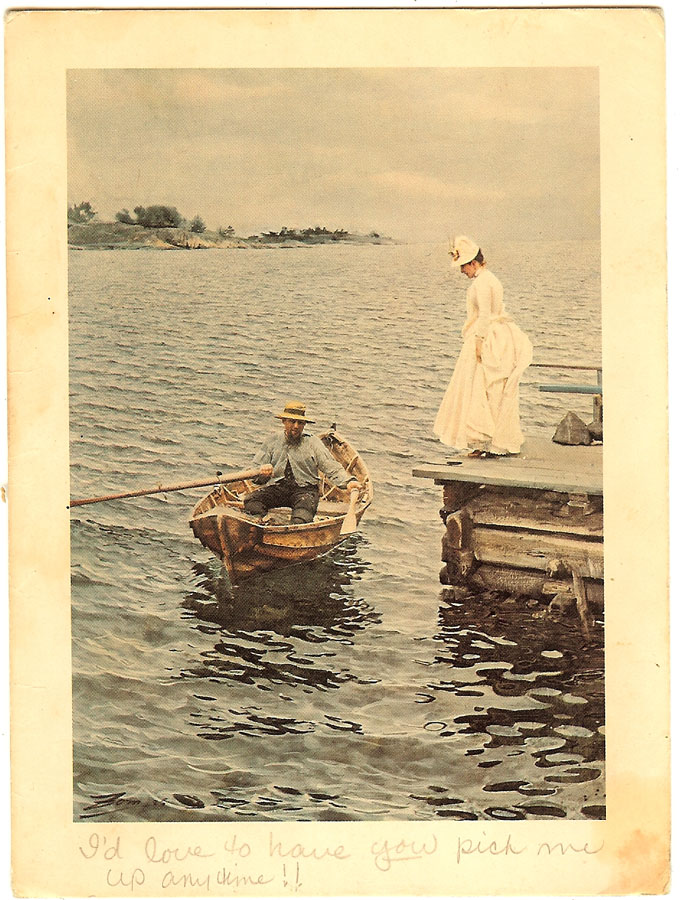
I thought of this card when I saw the prompt for this weeks Sepia Saturday. There is no kiss but there is water and a boat. Reading the card made me remember that I had written up my trip to Norway years ago, I didn’t have to write it from scratch. Hence this post.
This article first appeared in Catalyst Magazine in the Summer of 1990.
In June of 1981 I was 34 years old, three months pregnant and on my way to spend seven weeks in Norway with my then ten-year-old daughter Jilo. I left behind my husband Jim and three younger daughters, Ife 8, Ayanna 5 and Tulani 2. There were also several milk goats and a flock of laying hens on our 5 acres in rural Simpson County, Mississippi. It was my first time outside of North America.
I had been corresponding with Sister Peg Dunn, a nun, about our mutual interest in Sigrid Undset, Nobel Prize winning Norwegian author of “Kristin Lavrensdatter.” I had become intrigued after reading that she wrote her novels while raising six children. Sister Peg arranged for me to attend the International Summer School at the University of Oslo. Jilo and I traveled to Norway with her.
It is now 1990, nine years later. I’m 43, the yet-to-be-born-baby is 8 and Jilo will be 20 in June. We now live in Michigan. The goats and chickens are gone, but we’ve got rabbits and the garden grows larger every year. When I think about that trip these are my memories, excerpts from my journal and from letters I wrote home.
I remember wondering if those men wearing fatigues waiting to board my plane were hijackers. The pain in my ears as the plane descended. Hearing Danish spoken over the airport loud speaker.
June 16, 1981, Airport in Denmark
Dear folks,
We are drinking orange juice in Denmark and waiting for the plane to Oslo. Ten hours is a long ride! Only two more hours of dark and I am sleepy.
More soon.
Love, Kris
I remember the marigolds and petunias in the window boxes of the apartments and houses everywhere we went. Walking up0 five flights, seventy steps to the apartment we stayed in. Looking out of the kitchen window at the grass, women hanging out wash and children playing in the yard below. Walking, walking and more walking.
June 17, 1981 Wednesday, Oslo, Norway
Dear Jim,
We are staying with the lady poet that I met in Chicago. She gave me 2,000 koner ($400) in the bank here. Jilo and I walked all over and never got lost. Everyone does speak English so far. Women wear backpacks instead of carrying purses. Tomorrow the three of us will take a train to Trondjem – a seven hour ride, where we’ll stay in a youth hostel until Monday. I miss you.
Love, Kris.
I remember taking the train to Trondjem. How at one point, everybody (except us) got up and turned their seats around to face the opposite direction. How tired we got of the bread and salami and bread and salami and bread and salami, we had packed to eat. Mistakenly jumping off of the train before it pulled all the way into the station and then having to jump over the wires and cables to get to the station.
June 19, 1981, Dombas Norway
Dear Jim,
We are staying in a valley surrounded by snow capped mountains tonight. We walked a mile or more from the train station to the hostel with our backpacks. Was I glad not to have a suitcase!
Love Kris.
I remember not being afraid to walk around at any time of the day or night. The long days. At midnight it was dusk. Riding the train through glacial mountains. How low the clouds were. Seeing a waterfall in the mountains. Gudbrunsdal Valley. How hard it is to strain to catch a work you understand in a new language. How it is even harder to come up with one and say it. My discomfort at entering the World War II Museum of Resistance and being greeted in, surprise, Norwegian by the welcomers. How they saw my expression and tried French then, to my relief, English.
June 21, 1981, Monday, Dombas, Norway – journal entry.
Jilo and I walked around Dombas in the morning. There was a field full of the biggest, bright yellow dandelions I have ever seen. Someone was growing tomatoes under plastic covers…there were bus loads of middle-aged German tourists. Can’t help wonder what they were doing during WWII.
June 23, 1981. Wednesday. Oslo, Norway – journal entry.
A warm sunny day. Today we went out to Blinern University on the trikk (subway). Took a tour of the campus. Met a friend of Sister Peg’s for lunch in the cafeteria, Liv. She has a research fellowship here. Is married and has an almost two year old son, Mangus. She had taught a few years in Chicago. Had read and seen “The Women’s Room” on TV recently. Especially remembered the part where the woman is trying to quiet the two children and put them to sleep and the husband staggers out going to his mother’s where he can “get some sleep.” She said the wife should have thrown one of the babies at him.
We walked home, a half-hour, pleasant walk through a camomile covered field. At dinner preparation time (Jilo cooked) we blew the stove fuse and couldn’t figure out how to change it so had to eat cold leftovers.
Then we caught the trikk to another friend of Sister Peg’s. She lived in an apartment made from the second floor of her parents’ house. She taught English to adults and Norwegian emigrant children. She also had seen “Women’s Room” and liked it, although she said, it didn’t deal with the problems of her generation. She told us about the social discrimination against emigrants, poor people on the east side of Oslo (where the tour buses never go) and different dialects in Oslo and having her passport stolen from a basket she carried in the store. Those things didn’t used to happen, she said. She had been going to Poland. There was a candle on her table and along with wine, coffee, chocolates, nuts, coffee cake, Christmas cake, butter and goat cheese. Jilo drank solo (grape pop) She gave Jilo a snowflake pin and showed her a bunch of English books. One poetry book included the poem “Give you son forty licks, beat him when he sneezes.” She told us how she used to drag her younger sisters around by their feet when she was left in charge and they would act up.
I remember watching Ethiopians playing soccer in the field of camomile. Celebrating Jilo’s birthday in the mountains with whipped cream topped apple cake. The Folk Museums with old, old houses, stave churches and guides dressed in national costume. The festival day at school with the fiddler father, singing mother and dancing daughter. How they seemed to really be enjoying themselves. Eating lefse, roumergroten, flat brod and brown goat cheese, Jilo walking and riding the trikk all over Oslo, by herself, not speaking Norwegian and never getting lost or having any trouble.
June 29, 1981, Monday, Oslo – journal entry.
Today began cloudy and rainy but ended up nice and sunny. Met a Californian in the laundry room. A student from last year passing through, doing her clothes and reading Don Juan. Trying to lose her past. She asked if I’d found rules to live by. I told her my sister had. She also mentioned the fox in “The Little prince” and being responsible for what you love.
I remember the children’s party. Organized by a Mexican married to a Norwegian and a Bulgarian. The kids tossing balloons around. The Bulgarian complaining about her young chuildren catching colds so often at day care and balancing the children, her ex-husband and job. The Mexican singing “Las Mañanitas” for the son of a Norwegian woman who worked in the kitchen. Hearing the Royal British Wedding on television in another room while I washed clothes.
July 3, 1981, Friday. Oslo – journal entry.
Started out a very sunny, warm day until after lunch, ended up being cold and rainy. Jilo and I went with some students to the theatre. Before the play started a tall man came up and said that he should have written a synopsis and did I know the story? Then he started telling it to me. A fairy tale about a princess, a would be prince who had to get three feathers of a dragon to win her. Very good…I even understood a few words. The theater was old and big. We had to to to a small room up in the top or the play. Afterwards we went in the cold rain to a kiosk and got sausages, french fries and ice cream. We had agreed to talk only in Norwegian. Whew! I was cold with a dress, bare legs and sandals. But a good evening and it’s nice to be back in the room and warm!
July 2, 1981, Oslo
Dear Ayanna, This morning the Norwegian woman who cleans my room, washed the floor and was speaking Norwegian to me about my flower, but I couldn’t understand what she meant. I guess I have to study harder.
Love, Mom.
I remember realizing that the woman had put a saucer under the plant for me. Walking to the park past a mental hospital. The man people told me had been brilliant who stepped from one square to another square for hours at a time all day long when they let him out of the hospital. Seeing topless sun bathers. Vigelandsparken Sculpture Park with nude statues of all stages of life but, strangely I thought, no pregnant woman. The garden section, blocks and blocks of tiny houses for drinking coffee and eating cakes, surrounded by flower and vegetable gardens of those who lived in apartments. The strange feeling of living where Nazi soldiers had lived when they occupied Norway. Hearing my mother’s laugh coming from a group of students gathered on the steps below my window. Watching day by day as a young man worked on repairing the stairs…the girl that came and watched him, talked to him. just wanted to be with him.
July 19, 1981 Lillehammer, Norway
Dear Jim,
We did get out alive from Sigrid Undset’s bed and house. It was very strange. Reminded me of one of those Public TV mysteries where suspecting travelers are taken in and treated kindly by weird folk who later murder them in their beds. I discovered how Sigrid Undset wrote a Nobel Prizewinning novel “while raising six children.” She left the two step-daughters in Oslo and moved to Lillehammer with her two young sons and a nursemaid. There she wrote the first book of “Kristin Lavernsdatter.” She was tired after this because she had to keep interrupting her work to cook, clean, etc., so she brought tow more old houses. One small one for her husband (an artist) to paint in when he came out from Oslo and one for herself to work in. It is this one that we slept in and it is connected to the original house by an added on corridor. She also hired several maids and a cook., in addition to the nursemaid. She then left the kids and the servants in the original house and proceeded to write her masterpieces. She later had a third child and for many years later served as a foster mother to two Finnish war orphans…Her daughter-in-law, Christianna, was odd but very talkative and nice to us. She gave me two children’s books by Sigrid Undset (in Norwegian) and she got her young neighbor to drive us out to Undset’s grave about 15 miles away. There was a weird little man, about her age who she referred to as “the young man.” He tried to be pleasant, spoke no English and was always leaping around smiling. One time he was supposed to open a bottle of wine and he couldn’t find the corkscrew. He kept popping into the room and finally she sailed out after him. I expected to hear a loud smack as she boxed his ears, but she found the corkscrew and opened it. I could understand a lot of the Norwegian they spoke and that was encouraging. I had given up hope.
Love, Kris
I remember how awful it felt to be back in school studying Norwegian and how much I felt I was missing by sitting in the classroom when real Norwegians were all about talking real Norwegian and wonder still why I kept going to class.
July 22, 1981 – journal entry.
Homework very hard. Feel overwhelmed by busy work. Decided to skip class tomorrow and go on field trip with another class. Miss Jim. Interviewed by the newspaper, Aftenposten. Very poor English by reporter, better by photographer, nonexistent Norwegian by moi. Rather embarrassing. Jilo got us some Norwegian deodorant. It doesn’t work a bit.
I remember the lady from Denmark who sat next to us on the plane ride home and talked about how bad things were getting, she had to lock her doors now when she left her house, not like the old days. How dirty everything looked when we got back to Chicago and how good it was to see my family and eat home-cooked food again.


We Three Kings – Blog Caroling 2012
For this years Blog Caroling event hosted by footnote Maven, I decided to post my Carol from last year once again – We Three Kings on hang drum.

Christmas Visit – 1975
We moved to Simpson County, Mississippi in November of 1975. Jim was in charge of the Emergency Land Fund’s Model farm. Our daughter Jilo was 5 and Ife was 2.5. I was 29 and Jim was just about to turn 31. This was before we had goats, chickens or rabbits. The greenhouses weren’t in production. I remember several of the farmers Jim worked with gave him gifts of money for Christmas. It didn’t amount to more than $30 total but it paid for all the gas we used.

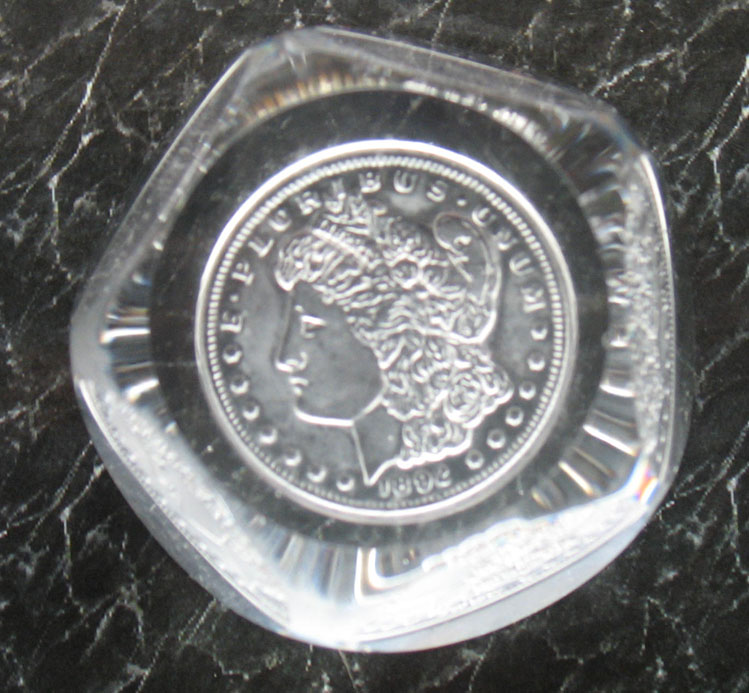
We decided to drive up to share the holidays with Jim’s family in Rock Hill, MO. They lived at #1 Inglewood Court, right outside of St. Louis. Seventeen year old Micheal, fifteen year old Monette and twelve year old Debbie were living at home. We made the eight hour trip in the little gray Volkswagon that came with the job. We took food to eat on the way, left early and drove straight through. I don’t remember anything specific about driving up. As I recall we got to St. Louis before dark. Jim’s parents gave us their bedroom. They were always so nice about that. Jim and the kids and I shared the pushed together twin beds. There weren’t presents for us but Jim’s mother looked around and came up with some. I don’t remember what she gave Jilo and Ife but she gave me two copper vases and Jim two glass paperweights. I don’t remember what we took as gifts.
I remember going to see Jim’s brother, Harold, at one of his jobs. He had several, just like his father always did. We also stopped by his studio where he made plaster knick knacks. Or was it cement bird baths? Or both? There was a Salvation Army or Goodwill store nearby and we stopped and I got some shirts for the kids and a dress that Ife wanted. Mostly we stayed around the house and visited.
We stayed until New Years Eve and left in the evening. There is never enough food or time to prepare it for the return trip. We stopped at Howard Johnson’s somewhere on the way home and I remember getting fried oysters. It was cold and dark and clear. There were stars. And there are always trucks. We listened to the radio and talked and maybe sang some. The kids eventually fell asleep in the backseat and we welcomed the New Year driving through the night.
Couple on a Bridge – Sepia Saturday #154
My Mother Smiling In A Hat – 1939 – Detrroit, Michigan
I was inspired to post this photo by a post on Between the Gate Posts “The Lady Wears The Hat“. It’s a beautiful photograph of her aunt.
What’s In A Name?
 I was named Kristin at my Uncle Henry’s suggestion, after the heroine of Norwegian author, Sigrid Undset’s trilogy, “Kristin Lavransdatter“. My mother had considered naming me after her mother, Fannie, but my grandmother said that was an awful name to inflict on a child, so she didn’t. My other grandmother, Pearl Reed Cleage, thought everybody should have a family name. In the case of my name she made an exception because it came from, she said, the best book in the world.
I was named Kristin at my Uncle Henry’s suggestion, after the heroine of Norwegian author, Sigrid Undset’s trilogy, “Kristin Lavransdatter“. My mother had considered naming me after her mother, Fannie, but my grandmother said that was an awful name to inflict on a child, so she didn’t. My other grandmother, Pearl Reed Cleage, thought everybody should have a family name. In the case of my name she made an exception because it came from, she said, the best book in the world.
The name Kristin reached it’s height of popularity in the 1940s, however my health care professionals seem to be continual startled to find such an old woman with the name of Kristin. They think that only younger people have received that name.
I’ve always liked my name, even though people like to spell it with an “e” instead of an “i”. During the late 1970s, Penguin Books came out with a new edition of the trilogy. I was stunned to read that Sigrid Undset wrote the series while raising 6 children. I was raising 4 and hardly had time to read, much less write Nobel Prize winning literature. I started trying to find out more about her life. I wrote letters to Undset experts at various universities and made connections that resulted in a 7 week trip to Norway in the summer of 1981. I found out how she did it and I will write more about that experience in another post.
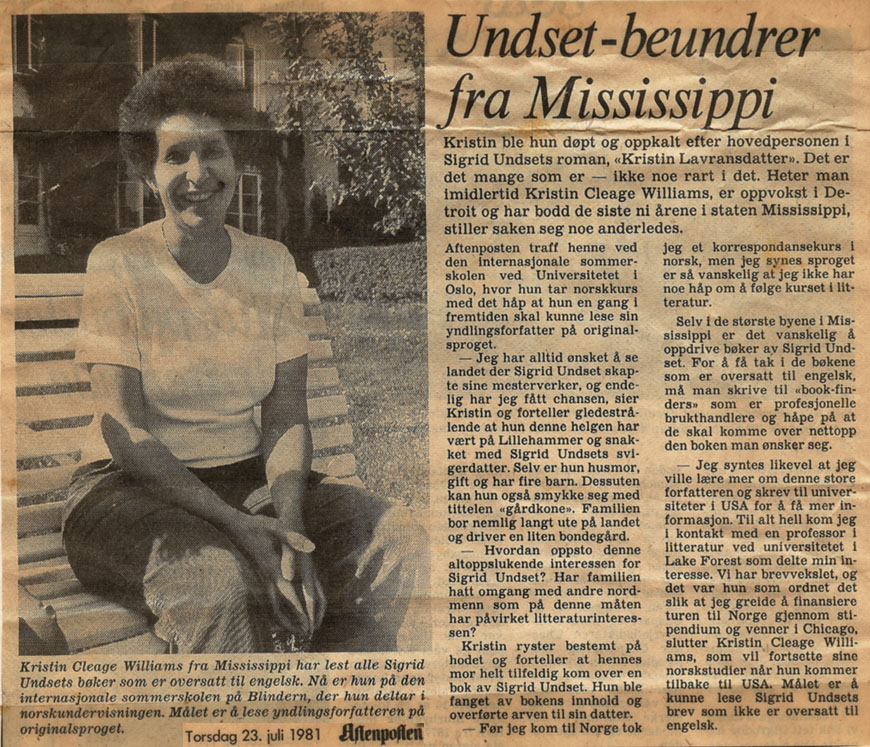
I got the idea for this post from Randy Sever’s Saturday Night Genealogy Fun, although I didn’t do it exactly the way he described.
Sisters Mary V and Doris Graham 1933
This photo of my mother, Doris and her sister, Mary V. Graham was taken in 1933. My mother was 10 years old and her sister was 13 years old. The photograph was taken on Belle Isle, an island park in the Detroit River between Detroit and Canada. You can see the river in the background.
They lived with their parents, Fannie and Mershell on Theodore Street. My grandfather worked at Ford Motor Co. at the River Rouge Plant. They had a dog named Bonzo. Their little brother, Howard, had died the year before from complications of diabetes and scarlet fever.
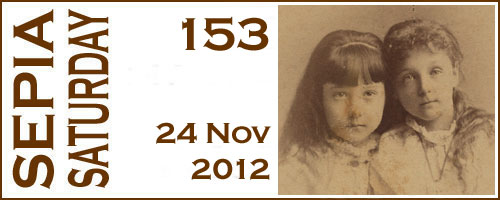
Questions I Wish I’d Asked

The generations gathered around my Graham grandparents dining room table in 1963 for Thanksgiving dinner. There was turkey with cornbread dressing cooked by my grandfather. There was white rice, cranberry jelly, green beans, corn pudding and sweet potatoes. There was my grandmother’s finely chopped green salad and her homemade biscuits with butter and with a relish plate holding olives, sweet pickles and carrot sticks.
One thing there wasn’t, was talk about the old days. My grandparents were born in 1888. My grandmother was born Fannie Turner in Lowndes County, Alabama. My grandfather was born Mershell Graham in Elmore County, Alabama. They met and married in Montgomery. My great great Aunt Abbie was born in 1877 in Montgomery, Alabama and was the second to youngest child of Dock and Eliza Allen. My mother told us stories she had heard from her mother, mainly about Dock and Eliza and their children. I remember once my older cousin was trimming Aunt Abbie’s toenails when Aunt Abbie mentioned that she used to trim her grandmother’s toenails when she was a girl. And that her grandmother also had arthritis. I have always remembered that, but I didn’t ask any follow up questions about her grandmother, Annie Williams who was born a slave and was full grown and the mother of a fully grown woman when she was freed. And Aunt Abbie didn’t say anything else about it.
My grandfather, who we called Poppy, was a mystery. My mother only had little parts of stories she had gotten from her mother, things that just made the mystery deeper in most cases. What were his siblings names and what happened to them? Are the ones I’ve found that I think are his siblings, really his siblings? In 1900, I found these possible siblings living with a man who is listed as their father but has a name not listed on any of their death certificates, was he their father with a different name? And where was he, my grandfather, in 1900? Why wasn’t he there, or anywhere else I can find? Where was their mother? What was the name of the little white girl he was servant of when he was a boy? The one he slept on the floor outside of her bedroom door? The one who changed his name from Michele to Mershell because Michele sounded too “foreign”? How did he learn to read? Did he go to school? Did he know his grandparents and what plantation did his parents come off of? There was a photograph of his sister and her children in the album. I would like to ask him what their names were. Are they the ones I’ve found in the census?
I would like to ask my grandmother some of the same questions about her father’s family. Howard Turner died when she was 4 and her mother moved away from that community and went back to her family in Montgomery. I was able to find her father’s family because I knew his name, his age and the community he came from but I have no stories about his parents and siblings or what plantation they came off of. I only know that his father, Joseph Turner of Hayneville, Lowndes County was a farmer and owned his own land and had given his son some land which he didn’t want him to sell and the two of them argued about it.
When we went by my other grandparent’s house for desert I would ask where my grandfather’s mother, Celia Rice Cleage Sherman is buried. And why my grandmother Pearl thought her grandmother was Cherokee.
Unfortunately, I can’t go back to 1963 and sit around the table and steer the conversation around to who was where and when and how and why. I can only use the information I do have to keep looking and hope that one day some cousins from those mysterious lines will turn up and perhaps have some of the answers to my questions.
_______________
This was written for the Blog Carnival “The Ancestors Told; the Elders Listened; We Pass It On”.

